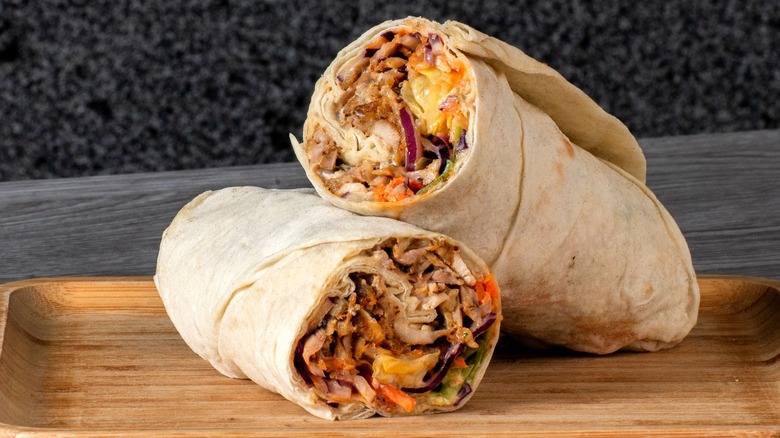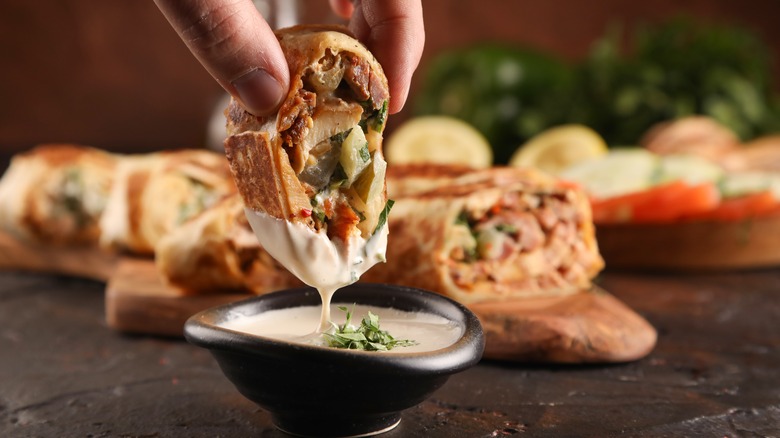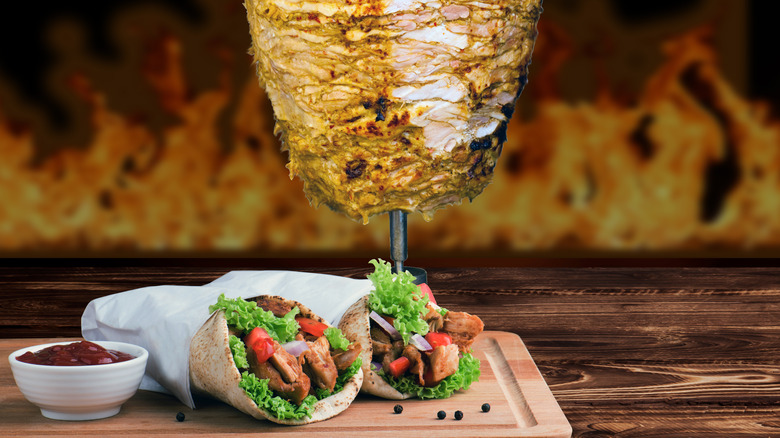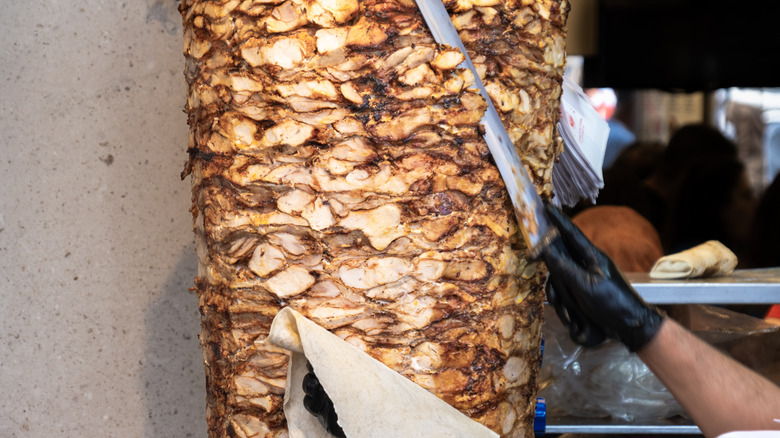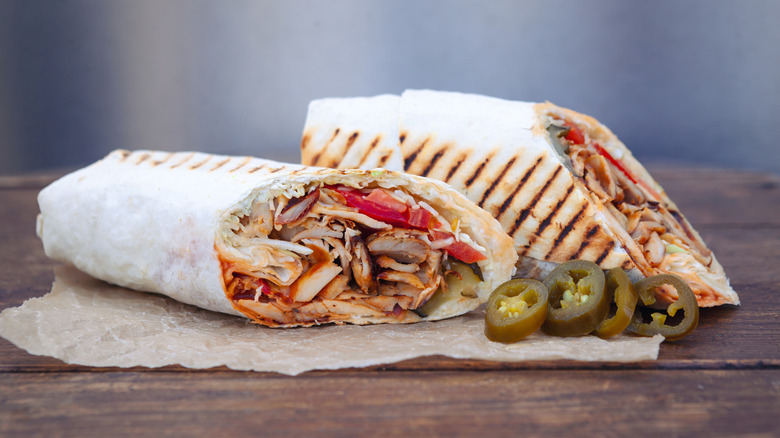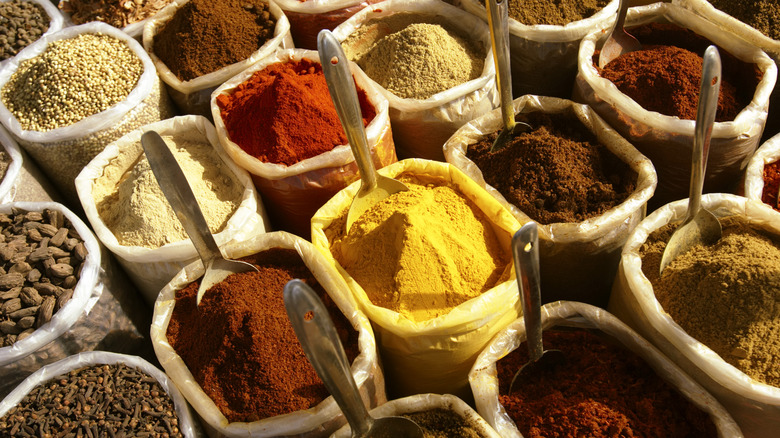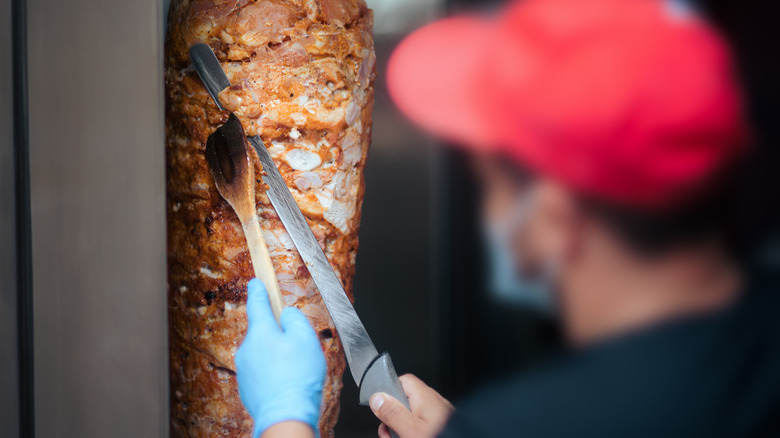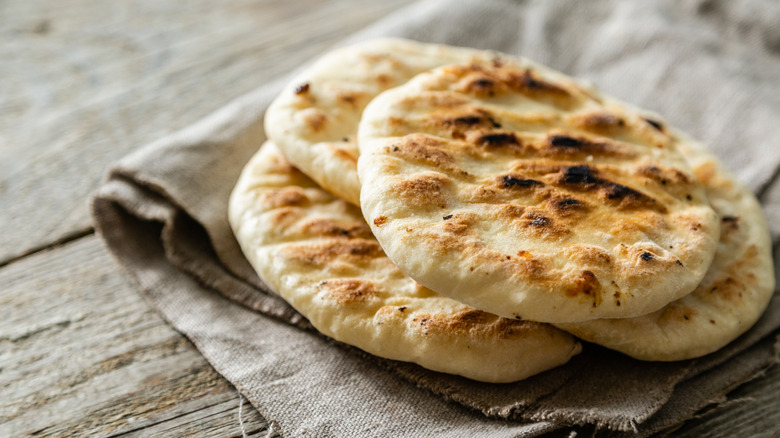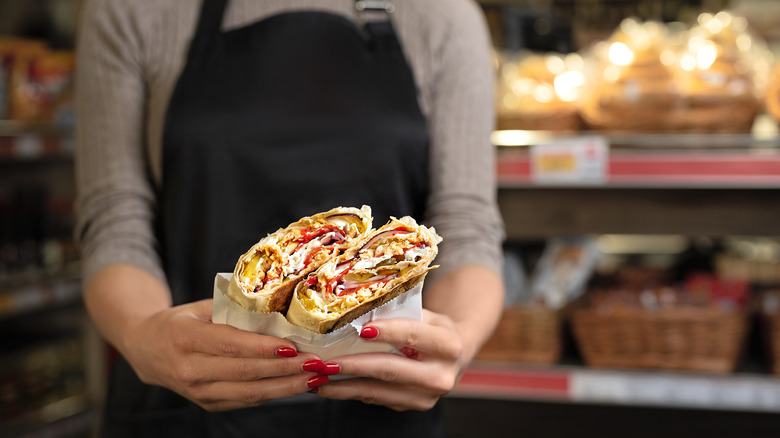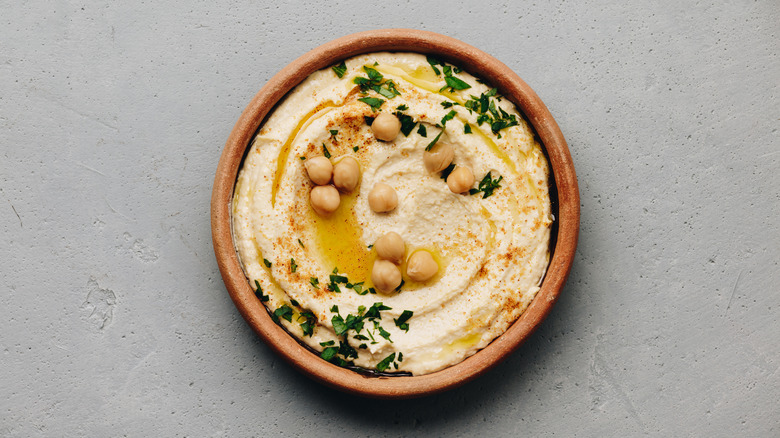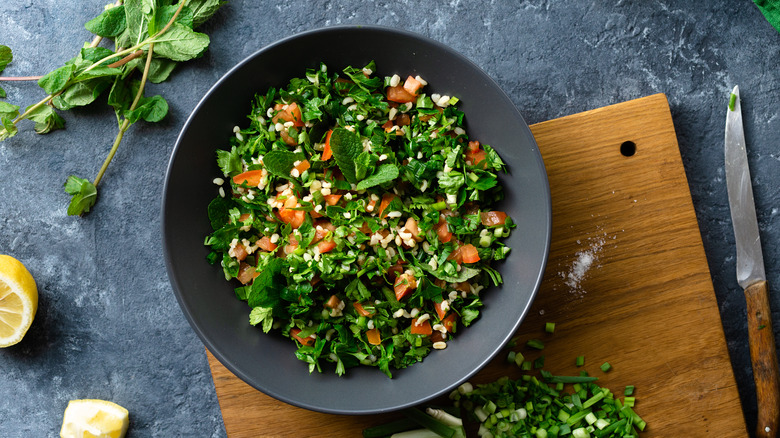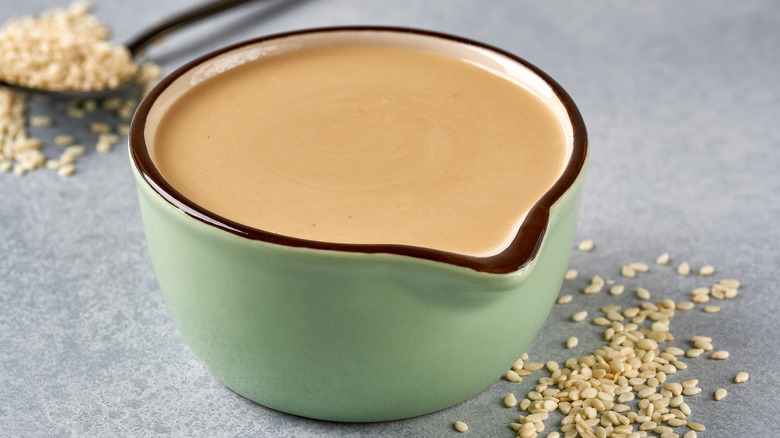What A Beginner Needs To Know About Ordering Shawarma
Listen up, everybody, we've got some news for you. We've finally decided on the world's most delicious food, and its name is shawarma. Okay, so we're exaggerating, but anybody who's ever tried shawarma will likely agree with us. This dish, comprised of heavily-spiced meat cooked on a vertical rotating spit until browned and juicy, and then piled on top of bread, served with accompanying salad and sides, is a stone-cold winner. And although it can look like other meat-and-bread sandwiches, shawarma is in a world of its own — a world that we implore you to visit.
A common food in the Levant and the Middle East, shawarma has seen a recent spike in popularity in the United States, thanks partly to its appearance in "The Avengers," which boosted its sales. But even though the shawarma boom is in full swing, it can still be a bit of a mystery to some people, and ordering it can be somewhat intimidating. Well, not anymore. From the basics of where shawarma comes from and how it's made, to how to maximize your topping and sauce game, we've got the lowdown on what you need to know so you can confidently nail your sandwich. Let's bite into the details of ordering this delectable treat.
To fully enjoy shawarma, learn its history
Food is arguably much more pleasurable when you know where it comes from. And we're not just referring to the origins of the specific product you're chowing down on, but the history of the dish. Shawarma is a meal that has a rich, lengthy history. The name itself comes from "çevirme", a Turkish word that is used to refer to something that rotates. It's thought that the contemporary version of shawarma was first developed around the end of the 18th, or turn of the 19th, century when the Ottoman Empire was in full swing.
From its first outings in the geographical location that's now Turkey, shawarma was able to spread outward into the surrounding regions, thanks to increased migration. As it did so, it took on even more variations, leading to region-specific adaptations and flavors. Although nowadays you can find shawarma in a huge amount of places in the U.S., it didn't start to gain traction until the 1970s. And from its original status as city-based street food, it's become a meal that can be found in restaurants across the country.
Shawarma is not the same as other meat sandwiches
One of the main issues that shawarma faces is distinguishing itself from other similar meals. At first glance, it can be tough to tell the difference between a shawarma sandwich, and other comparable dishes like gyros or kebabs. This can lead to people lumping them all in together, which then compromises your getting an authentic, specific meal.
So, if you want true shawarma, you need to figure out how it's different. Shawarma is often confused with the gyro sandwich, thanks to their meat being cooked similarly and both being served stuffed into pita bread. Gyro, however, has Greek origins and flavorings, served with a tzatziki sauce and often seasoned with herbs like oregano and thyme. Shawarma, on the other hand, is flavored with spices and is usually topped with tahini sauce. Gyros may also sometimes have french fries stuffed into the sandwich with the meat, whereas shawarma doesn't.
Another common meat-and-bread combo that shawarma is lumped in with is the kebab, and specifically the doner kebab, which is another meat dish cooked on a rotating skewer. Again, though, while they're closely related, the two dishes are different, thanks to their roots and seasonings. Doner kebabs are of Turkish origin. Shawarma is usually found in the Middle East, the Levant, and Egypt. Doner kebabs also tend to be seasoned more lightly than shawarma and are usually made with specific meats like lamb or mutton.
You can have a choice of meats
In a portion of shawarma, the meat is arguably the most important part. The heavily-flavored, warm mountain of protein that's the center of every shawarma sandwich provides both spice and sustenance.
But one of the best things about shawarma is that you're not bound to just one type of meat. Depending on your preference, you can grab shawarma that's made of either lamb, chicken, or even turkey. You can even grab a shawarma that's made of veal meat if you're so inclined — and if the restaurant you're ordering from has it, of course.
Just bear in mind that the meat that you order will likely affect the flavor of your sandwich somewhat. Lamb tends to have a slightly gamier flavor than other meats, and so it can be a little meatier-tasting than proteins like chicken or turkey. Your meat choice could also affect the nutrition of your sandwich. Opting for a shawarma made primarily of white meat, for example, will probably be lower in fat than those made with red meat. And if you can't make up your mind about which meat you want, the good news is that most shawarma joints have a mixed-meat option, so you can try a little bit of everything.
Shawarma may be kosher and halal, but not always
Eating within dietary frameworks can take a little extra attention sometimes. And so, if you follow a kosher or halal diet, it might be useful to get to know whether shawarma fits into your lifestyle. The simple answer, unfortunately, is that there's no one-size-fits-all approach when it comes to shawarma. Certain restaurants may make their shawarma with halal meat, where the meat is slaughtered under specifically-observed conditions, and the item can be found on halal menus worldwide. This isn't always the case, though, and whether the meat is halal or not in your local eatery can vary widely depending on the process the food goes through, its owners, and its demographic.
The question of whether it's kosher or not is similarly dependent on how the food is prepared, and specifically with shawarma, what it's paired with. Kosher dietary rules state that meat and dairy items can't be paired together. This can become a problem with shawarma when your meat is being served with a dairy-based sauce, which although more likely to happen with a similar sandwich like gyro, may still occur. If you have any doubts about whether the sandwich you're ordering fits your lifestyle, the best thing to do is to ask your server or chef how the food's made.
Shawarma meat is heavily spiced
One thing you need to know about shawarma is that when it's made well, it's never lacking in flavor. And a huge part of that flavor comes from the multiple spices that give it its unmistakable taste. Shawarma meat is marinated in a spice blend before its skewered onto the large spit. These spices are commonly used in Middle Eastern and Mediterranean cooking, and the average shawarma recipe can contain the flavors of cardamom, cinnamon, allspice, cloves, cumin, and paprika, amongst others. The spices utilized typically don't add a huge amount of fiery heat, but rather provide warmth and depth to the meat.
Some recipes may also use onion or garlic powder, with garlic powder, in particular, providing the dish with additional umami flavors. It's worth remembering, though, that shawarma spice is not the same everywhere you go. As shawarma is popular in many different countries and with many different communities, the spices used can vary from place to place, depending on the culinary traditions of the people making it.
Its fat content is partly what gives shawarma its flavor
If you've ever seen a rotating, gently browning stack of shawarma meat, you might wonder how it doesn't dry out before it reaches your plate. And the answer lies in its fat content. A good amount of fat is essential to making the tastiest shawarma possible and provides flavor while simultaneously keeping the meat moist and tender. When a shawarma stack is made, chefs will put pieces of fat directly between the layers of meat. Then, when the shawarma cooks, this fat melts into the meat itself, lending it a succulence that can't be beaten.
This added fat is especially useful when your shawarma is made with white meat, like chicken or turkey. As white meat has a lower fat content, it stops it from becoming stringy and tough on the skewer. As you can probably imagine, though, all of that fat can make shawarma a slightly heavier meal than if you were eating a plain chicken or turkey breast. That's all the more reason to pile your sandwich high with any of the delicious salads on offer.
Where you order it might change how it's served
Shawarma is one of those dishes that's beloved all around the world. But, like any other meal, it can be adapted to suit local tastes and preferences, as well as to utilize the meats or spices most available. If you're ordering shawarma anywhere in the Middle East, you're likely to find that the dish is usually made with lamb. This is arguably partly due to the limiting of other meat products, like pork, due to religious observance, which means that lamb has become more popular as a primary choice.
The exception to this may be shawarma made in Israel, which may be found more commonly made of turkey. In non-Middle Eastern countries, the type of meat used can vary widely, with pork or beef options more commonly found in European and Western areas. It's not just the type of meat used that changes, either, but the serving styles of the dish. In some regions, you might find that serving it with garlic sauce is more common, whereas others might favor using hummus and tahini. In our opinion, all of this variation is just more excuse to take a shawarma tour of the globe!
Shawarma can come with a variety of bread
Now, obviously, the star of the show when it comes to shawarma is the meat. We're not disputing that. But can we have a round of applause for the bread, too? No shawarma is complete without a fluffy piece of bread to encase it in, giving the perfect vehicle for all of that protein and the delicious sauces.
The kind of bread you get, however, will depend on where you're ordering it from, and some restaurants may have multiple options — so choose wisely. Typically, shawarma will either come stuffed into a pita as a sandwich or wrapped in a pita or flatbread to make a meal that resembles a burrito. Although pitas and flatbread seem pretty much identical, there are a few differences between the two. Pita bread is made by baking it and contains yeast, whereas flatbreads do not (which is partly why they're so, y'know, flat). This means that pita bread can be slightly thicker than flatbreads, so may be the preferred option if you're looking for your bread to stand out a little more in your shawarma. Generally, though, you won't find too much difference in terms of taste, especially if both bread options are unflavored and made with white wheat flour — so it comes down to personal preference.
The place you're ordering it from matters
Ordering shawarma when you've never tried it before might be a little bit stressful. And it can get even more nerve-wracking if you're not 100% certain about the safety of the place you're ordering it from. While the cooking method for shawarma is perfectly safe, it's understandable to be concerned about the sight of meat sitting out in the open, and potentially not being fully cooked or sanitary.
The main thing to look out for, though, is whether the shawarma joint you've chosen has a good amount of customers. "If the shawarma place isn't busy, stay away. That whole process depends on the meat being continuously cooked and served," states an in-the-know commenter via Reddit. If the restaurant is totally empty, there may be a chance that the chef has turned off the rotating meat to avoid it drying out. However, this can result in warm, half-cooked meat sitting idly until the next customer comes in. And when meat sits too long at lukewarm or room temperatures, it can be prone to growing bacteria, with food between 90 to 140 degrees Fahrenheit becoming unsafe to eat after just an hour, says the USDA. Always opt for the busy places, folks — they're probably busy 'cause the food is so good.
Don't shy away from the unique toppings
So, you've placed your shawarma order, you've nailed your ideal combo of meat and bread, and the sandwich is sitting, waiting to be loaded with toppings. And then ... you hesitate. What do you choose? And what's that pink-looking thing — and will it ruin your sandwich?
Now is the moment to be brave, people. Shawarma is always better with a range of toppings, and while you can opt for what you know, it's a great opportunity to try something new. Shawarma is typically served with a range of sliced vegetables like onion, tomato, cucumber, lettuce, and cabbage. But placing pickles on shawarma is also common, and alongside pickled gherkins, pickled turnips are also popular. These turnips are usually bright pink, thanks to the pickling liquid they develop in, and have a super-sharp, almost radish-like flavor. This astringency gives the perfect counterpoint to the juicy, spicy meat, and balances the whole meal.
As well as getting part of your five a day on your shawarma sandwich, you can also opt to top the meal with a dollop of hummus. Finish the whole thing off with a squirt of sauce, and you're good to go.
If you're hungry, don't forget the sides
Shawarma sandwiches are generally pretty filling, but if you're looking to make a full meal out of your order, now is the moment to go big on the sides. And the best part is, there are so many side dishes that pair perfectly with shawarma meat. If you're looking to keep things simple, a portion of french fries is a great choice and can make your dish way more substantial. Falafel can also be a popular option and can provide both additional protein and carbs while keeping things spicy.
However, we're huge fans of pairing shawarma with more traditional salads like tabbouleh or fattoush. Tabbouleh salad, a dish that's super-popular in Lebanon and the Middle East, is a salad made with parsley, bulgur wheat, and chopped tomatoes. Its parsley content doesn't just provide a freshness that counteracts perfectly with the rich meat, but is also positively crammed full of important vitamins and antioxidants. Fattoush is another Middle Eastern favorite and is a salad made with cucumbers, tomatoes, onions, and parsley, and frequently topped with fried croutons of flatbread or pita. Trust us, once you order either of these, you won't go without them again.
The sauce you choose makes a big difference
It's time to get saucy, folks. Few sandwiches lend themselves as well to an abundance of sauces as shawarma does, and in most restaurants, you can choose whichever slathering of sauce you desire. Shawarma is traditionally served with tahini sauce, a condiment that combines ground sesame paste (or tahini) and other flavors. Tahini sauce provides a super-nutty, mellow flavor, that works well with the spiciness of the meat and fresh salad options.
But there's no reason to stop there. If you want a slightly creamier element in your sandwich, try going for a yogurt or garlic sauce. Garlic sauce is particularly good with chicken shawarma and can provide additional moisture and freshness to the dish. Shawarma, especially those from street vendors, can also be served with amba, a type of mango pickle that can get pretty fiery. Some shawarma restaurants will also have chili or hot sauces which can amp up the heat content of the sandwich, and is particularly useful for folks who like things spicier, as on its own shawarma doesn't often provide intense piquancy or heat.
